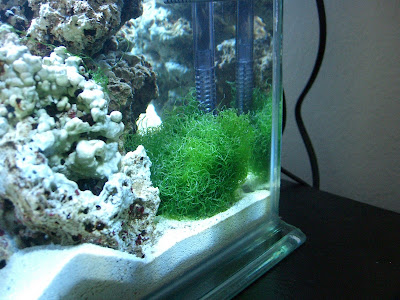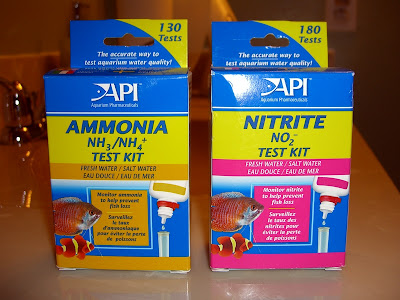

A Detailed Account of My Miniature Reef Experience




















 I poured a small cup of water from my tank into the bags every ten minutes after throwing out a cup of water from the bags.
I poured a small cup of water from my tank into the bags every ten minutes after throwing out a cup of water from the bags.
 The blue zoanthids hid their polyps for the first two hours but eventually opened up. The purple mushrooms all opened up nicely except for the big one which is still pretty shriveled up from the transfer.
The blue zoanthids hid their polyps for the first two hours but eventually opened up. The purple mushrooms all opened up nicely except for the big one which is still pretty shriveled up from the transfer. I found some pretty interesting hitchhikers on the coral rocks: bristle stars, some mystery anemones and something that looks like a feather duster but might very well be a coral polyp of some sort. At this point, it's too small to tell.
I found some pretty interesting hitchhikers on the coral rocks: bristle stars, some mystery anemones and something that looks like a feather duster but might very well be a coral polyp of some sort. At this point, it's too small to tell. 


The calcium level is a bit high. Ideally it should be somewhere between 400–500 mg/L. A level this high shouldn't be too alarming but fluctuation in levels can cause pH and alkalinity levels to fluctuate as well, which isn't a good thing. For now I'll have to monitor the calcium level carefully to make sure it stabilizes. On the plus side, this high level of calcium is probably responsible for the rapid growth of coralline algae.
As far as livestock, today I found an empty nassarius snail. Not sure if it died on its own or if it was attacked by one of the hermits. The hermits have been playing nice with the snails all this time though so I'm ruling that possibility out for now. My clean-up crew in general can't seem to keep up with the algae growth so I will have to add a few more recruits.
With the tank's steady progress and stable parameters, I might just be ready to throw in my first coral this weekend.






I placed a clump of chaeto in the rear right corner of the tank where it is tucked away yet it can still receive the sufficient lighting that it needs. It's also in the spot where the power filter and the powerhead intakes are located so it receives good circulation but not so much turbulence that would otherwise scatter it all over the tank.

Notice from the top how this spot is conveniently concealed:

With its fast growth rate, the only thing I have to make sure is to tumble and harvest it regularly to keep it from taking over the tank and getting everywhere. In return, it will help maintain stability in my tank.
Today's Expenses:
TOTAL COST: $18.30

Here are the test tubes with those readings:
I did a 10% water change and replaced the stock carbon filter with Purigen for stronger chemical filtration. While the use of activated carbon in reef aquariums (there's a link to a good article on the right) is debatable depending on who you speak with, I think it's an important component in order to maintain stability in a tank this size. It removes dissolved organics and selected chemicals from the water by absorption and adsorption.
Anyway all geek talk aside, Purigen comes highly recommended by people as it's supposedly 500% more effective than your ordinary activated carbon.
I got a 250 mL bottle of Purigen that's formulated to treat 250 gallons of water which means that a gallon of water can be treated with 1 mL of Purigen.
Purigen has the consistency of tiny little beads so I got a filter media bag to put the stuff in.
They recommend you rinse the filter (with RO/DI water, of course) prior to placing it in the filter. Doing so didn't release any residue or debris in the water so I'm not exactly sure why they tell you to do this.
I also got a mini Mag-Float which comes in handy for cleaning algae off the glass. Up to this point I've been doing it ghetto style—sticking my hand in the tank and scraping the algae off with my fingers.
Copious amount of debris have settled on certain parts of the live rock where the diatom bloom use to be, trapped under a layer of biofilm. This is a perfect time for me to pick out a clean up crew to help clean some of that mess.
Today's expenses after a recent trip to Petsmart:
TOTAL COST: $32.69 (plus tax)

The test results actually gave me some new figures though I'm still sketchy about its accuracy. While the ammonia is showing at less than 0.25 ppm, it's still not completely down to zero although nitrite is down to zero all the way. Nitrate is reading at 2.5 ppm but is reading at zero with the API tester.
As tempting as it is for me to start adding livestock at this point, it's probably best to wait for a couple more weeks until I know for sure that my parameters are stable and that the levels of ammonia, nitrite and nitrate are consistently down to zero.

 So I ran out and picked up a different test kit. This time I got the Reef Master Test Kit by API. This test kit has testers for everything important you need to know in a reef aquarium: carbonate hardness, calcium, phosphate and nitrate, but not ammonia and nitrite. There's another test kit called Saltwater Master Test Kit that has testers for ammonia and nitrite, but not calcium and phosphate. I figure as my tank matures, I'll be using the Reef Master Test kit more and more so I opted for this instead.
So I ran out and picked up a different test kit. This time I got the Reef Master Test Kit by API. This test kit has testers for everything important you need to know in a reef aquarium: carbonate hardness, calcium, phosphate and nitrate, but not ammonia and nitrite. There's another test kit called Saltwater Master Test Kit that has testers for ammonia and nitrite, but not calcium and phosphate. I figure as my tank matures, I'll be using the Reef Master Test kit more and more so I opted for this instead.
The calcium reading is at a normal level and the phosphate result is a relief and again helps to point the diatom bloom back to high nitrate levels. In any case, this calls for my scheduled and probably much needed water change.
So I did a 10% water change and hopefully this will improve water parameters in the next week. I also cleaned out the media in the power filter and rinsed them with reverse osmosis water.
Mod of the Week

My expenses this week:





The pH is slightly lower than it needs to be which should be within the range of 8.1-8.4. Ideally around 8.3. This is important in absorbing a certain amount of acidic matter produced by waste. This correlates directly with my ammonia and nitrite level which I will soon get into. The alkalinity on the other hand is right where it should be which is a good thing as this helps prevent the pH from going any lower.
The ammonia and nitrite levels are pretty low and should expect to see them close to zero by the end of the week. This is one of the reasons why I waited until midweek for the first test as an earlier test would have shown a spike in ammonia from the amount of initial die-off. The nitrate level reading higher than the first two can only mean that nitrobacter has already started the process of converting nitrite into nitrate.
For full information on the nitrogen cycle refer to the resource link at the sidebar.
UPDATE: Upon further research, I've come to the conclusion that the Red Sea Marine Lab is highly unreliable. So unreliable they shouldn't even be selling that stuff! I'd recommend test kits by Aquarium Pharmaceuticals or Seachem. Salifert test kits are apparently the best ones. Pricey, but reliable and highly recommended.